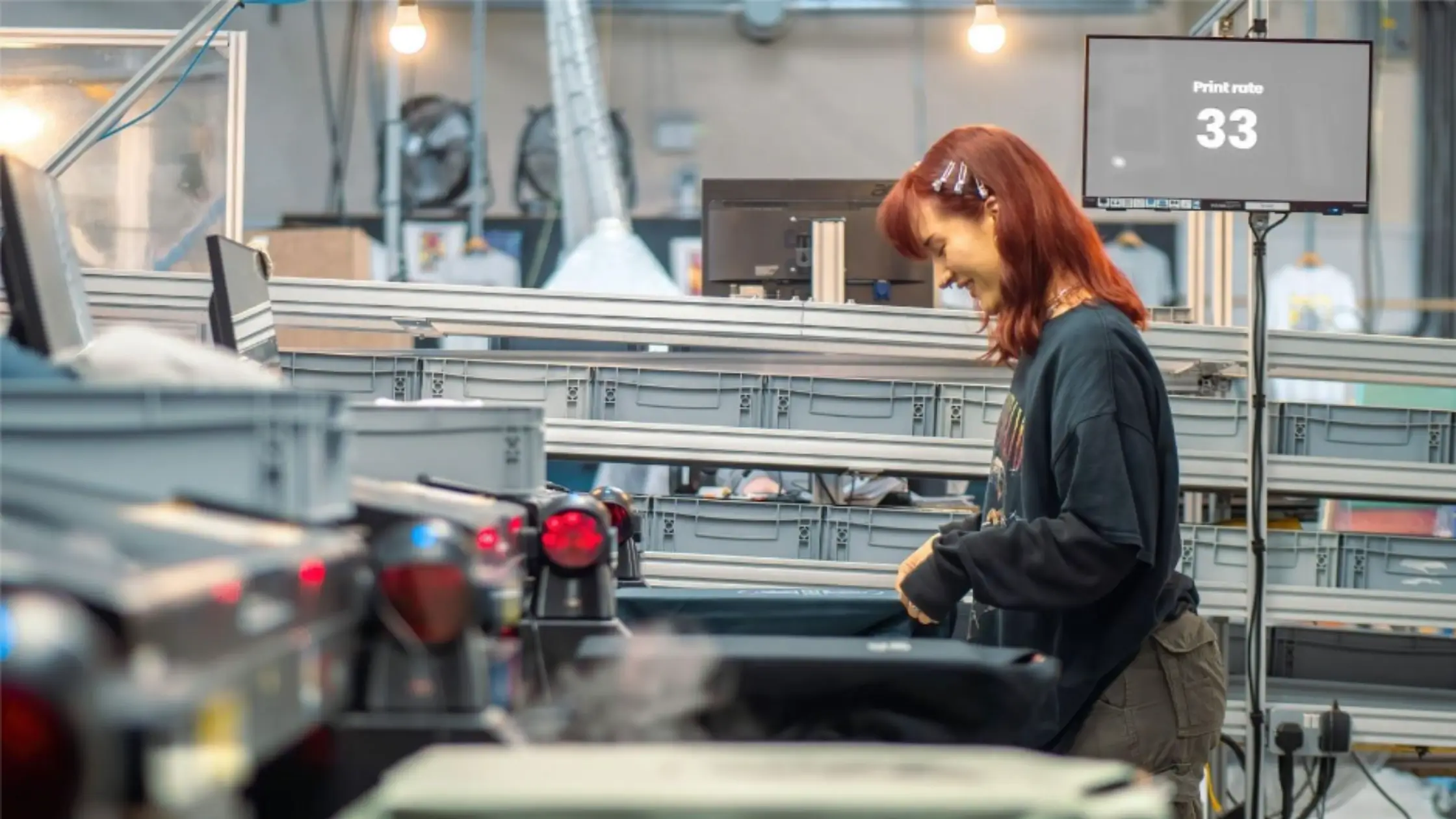It can be hard to know where to get started with ecommerce.
While e-commerce thrives on the adaptability and flexibility of its many models, some ecommerce options provide a greater barrier to entry than others.
Building your own store, becoming an Amazon partner, selling old clothes on second-hand marketplaces - there have never been more genuine ways to make it in ecommerce.
In our minds, print on demand stands alone as the perfect simple, flexible and sustainable entry point for ecommerce beginners.
But what is it about print on demand that makes it so appealing and prime for scaling?
Skip to:
Custom design created in Canva
What is Print on Demand?
Print on demand is a popular retail and publishing model that allows for the creation of custom, small-batch, and limited-run products printed upon order.
Items like linen dresses can be custom-printed, catering to the rising demand for stylish and comfortable apparel. This approach eliminates the need for large-scale production and inventory storage.
Print on demand services cover a wide range of popular products, including garments, books, art prints and more. The process has been hailed for its implications for waste reduction, flexibility and point of entry.
Print on demand integrations for popular platforms such as Shopify and Etsy have further simplified the process for new and existing store owners.
It gives smaller brands the opportunity to explore monetization options for their social audiences and a sustainable alternative to mass production.
E-Commerce Print On Demand Business (4 Reasons to Start)
- Low up-front costs
- Makes it easier to run a sustainable business
- Offers room for experimentation
- Allows you to sell internationally

Image - Unsplash
1. Low up-front costs
Getting started in ecommerce has traditionally come with significant investment costs.
Despite being sold as a great source of alternative income and a starting point on the road to financial independence, ecommerce is not that straightforward.
Starting your own store isn’t just a case of selling products.
You must consider other things, like,
- website management
- logistics of stock storage
- order processing
- customer service
- marketing
All of which require a significant financial and time investment. Before long your work from home ecommerce dream is a nightmare of half-packed orders, invoices and unexpected costs.
Print on demand renders these challenges irrelevant, taking the process of printing, packing and shipping orders out of your hands, with suppliers managing everything to do with the physical order for you.
This gives you more time to focus on branding and marketing, safe in the knowledge your customer’s orders are being processed by an experienced team of experts.
By opting for the print on demand model, you’re making a low investment choice, without sacrificing any of the security. Print on demand suppliers typically charge low fees to use their service, or simply take a percentage of each sale you make.
That means a super low initial investment that allows you to get started selling right away.
No more worrying about renting warehouse space for stock, the only investment you need to make is marketing your store.
Print on demand allows you to grow a business at your own pace. Thanks to low investment, you can dive in whenever you feel like it, without the pressure of justifying a huge investment cost.
While many POD stores find the process to be highly scalable, there’s no pressure to provide constant growth, with no initial costs, investors and unsold stock hanging over your head.
2. Makes it easier to run a sustainable business
There have never been more reasons to start a sustainable business. The environmental impact of ecommerce has long been the industry's black mark.
Studies have highlighted the mass waste produced by packaging from major ecommerce suppliers such as Amazon, much of which is not recycled. This is endemic across ecommerce, particularly as packaging becomes an increasingly important part of branding.
This is highlighted in the disparity between how ecommerce brands view sustainability and the importance consumers place on it, with only 56% of consumers ranking brand name as somewhat or very important.
By contrast, between 2017 and 2022, searches for sustainable products increased by 130%.
There are so many reasons to run a sustainable business right now:
- Become a responsible business contributing to the fight against climate change
- Customers are actively searching for sustainable products
- Putting sustainability at the heart of your business builds customer loyalty
- Focusing on sustainability positions your business and products for regulation changes in the future
Print on demand is an inherently sustainable e-commerce model.
By printing exclusively to order, you avoid waste typically associated with ecommerce, such as piles of unsold clothes, low-quality garments designed for mass production, costly individual delivery and cheap plastic packaging.
However, working with sustainable suppliers who cover everything from supply chain to packaging is the absolute best way to ensure you’re building an eco-friendly business.
3. Offers room for experimentation
Adaptability and experimentation are two of the strongest assets of print on demand.
Print on demand has revolutionized artists and creative’s potential to bring their work to market. With print on demand, experimenting with new designs or monetising your audience is low risk.
Had a fresh idea for a great design? Put it on your website and see how your audience reacts!
If no one makes an order it doesn’t matter, you never had to take the risk of pre-ordering stock.
One of the most significant advantages of print on demand is the ability to swiftly respond to trends and audience preferences. As a new print gains traction, it can swiftly be materialized and put out into the world, capitalizing on its momentum.
This agility is invaluable, enabling creatives to keep their content fresh and relevant.
Likewise, as your audience’s habits change and new followers find your work, you can quickly add to or adapt your designs to better appeal to them.
Moreover, this flexibility liberates artists to experiment freely, with trial designs and new items easily testable, serving as a playground for innovation.
Short runs are a proven retail strategy, not only minimizing financial risks but also serving as a tool to build anticipation and interest in an artist’s brand. This strategy allows for the gradual expansion of offerings, keeping the audience engaged and eager for what's next.
Print on demand lets artists be artists, rather than forcing them to become retailers, warehouse managers and everything in between. It removes the logistical barriers, allowing them to unleash their creativity, respond to market demands, and engage with their audience organically.

Image - Unsplash
4. Allows you to sell internationally
Ecommerce success in 2023 demands serving the international market.
If you’re not able to supply customers across the globe, you’re severely limiting your business and brand potential. With many ecommerce brands starting life on social media, it’s important to have a method of serving followers based outside of your region.
Read more about the e-commerce conversion funnel.
However, building unique websites for international audiences and shipping across the world can be very expensive, eating directly into your profit margins. Retaining the quality of your products while shipping internationally can be a costly and complicated process.

Image - Statista
Print on demand significantly simplifies the process of selling abroad. As all orders are processed, packaged and shipped from one supplier, you don’t need to consider the complications of managing orders to multiple countries.
Likewise, you can provide a consistent experience for customers anywhere, ensuring they receive the same quality of product, packaging and customer service. As long as you’re working with a supplier that operates and ships internationally, you can open your store up to multiple markets.
Conclusion
The ideal ecommerce model for you is contingent upon your unique offerings and business structure, regardless of just how new to the market you are.
However, the print on demand approach aligns with the eco-conscious values of today’s consumers, offering rapid, cost-effective services that cater to the essential adaptability crucial for emerging businesses.
Whether you’re trying to be a sustainable business or bring your art to life, print on demand is the perfect starting point.



